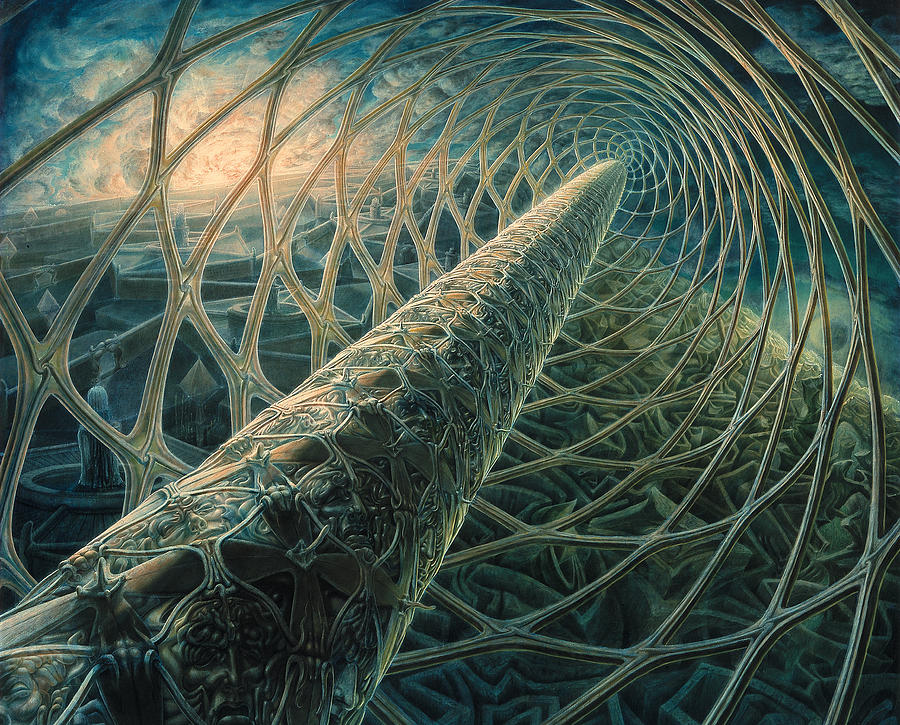Fantastic realism is an art style that emerged in Austria in the middle of the 20th century. Fantastic realism depicts images that can’t really be explained, but drawn in the style of traditional realism, combining abstract art with incredible realism technique. It is described as ” dreamlike visions from the subconscious painted in a realistic manner”. Coming in the wake of World War II, It often has themes of birth and vitality, combined with brutal themes of death and war. The pieces are often very chaotic and highly detailed, but difficult to interpret exactly what you are looking at. What makes this style intriguing to me is that it feels like its depicting a scene or place that actually exists, but you know that it doesn’t. It feels both human and non-human at the same time.
In 1946, the Vienna School of Fantastic Realism was founded by Ernest Fuchs, among others. Fuchs Below are two of his works, entitled “The triumph of Christ” and “The Anti-Laokoon”.


One artist whos work I really enjoy is H.R. Giger. Giger studied under Fuchs, adding his own twist on fantastic realism by incorporating “biomechanical” elements into his designs. The style of Fuchs can be seen in Giger’s art, but with the added mechanical and alien aesthetic and his signature airbrush style. His art directly inspired the visual direction of the movie “Alien”, which he also did design work on first hand. Below is a piece by Giger called “Necronom IV” – 1979 , which directly inspired Ridley Scott to reach out to Giger for help on the film. The second image is a piece called “Biomechanical Landscape” – 1979. As a mechanical engineer, the meshing of organic and mechanical elements is really interesting.


Works by De Es Schwertberger, who was a contemporary of Giger who also studied at the Vienna School of Fantastic Realism under Ernest Fuchs. His work captures dreamlike landscapes in a realistic style.



Fantastic realism also influenced other styles such as visionary art, which incorporates more spiritual and mystical elements.

Fantastic Realism is still evolving today. Below is an image from the 2022 game entitled “Scorn”, that is a direct ode to the work of H.R. Giger.

Works Cited:
Websites:
https://www.tate.org.uk/art/art-terms/f/fantastic-realism
https://milenaolesinska77.medium.com/ernst-fuchs-vienna-school-of-fantastic-realism-74cab82e3c22
https://arthive.com/styles/fantastic_realism
https://en.wikipedia.org/wiki/Vienna_School_of_Fantastic_Realism
Images:
https://www.visionaryartexhibition.com/visionary-community-blog/archives/06-2015
https://milenaolesinska.blogspot.com/2018/11/ernst-fuchs-vienna-school-of-fantastic.html
https://fineartamerica.com/featured/no-end-de-es-schwertberger.html
https://fineartamerica.com/featured/deep-forest-de-es-schwertberger.html
https://www.widewalls.ch/magazine/visionary-art
https://www.shacknews.com/article/132702/scorn-review-everything-hurts-im-dying


3 Comments. Leave new
Hi Luke- when looking at each students’ blog post topics in our class, I was immediately drawn to yours because fantastic realism is an aesthetic that I have heard of in the past, but never truly understood what it was or what it meant, and I wanted to learn much more about it. For me personally, one of your greatest strengths with this blog post was how you thoroughly explained this design aesthetic in real human terms, which allowed me to develop a more genuine understanding and depiction of the style, as opposed to if you had just copied it straight from google. A lot of the times, even if google’s definitions may theoretically be more “accurate” or “high-level,” the language that is being used to describe the aesthetic is too formal, making it difficult to truly understand what is being defined. Because you were able to explain the aesthetic in more humanistic terms while still managing to have it be refined accurately, it reminded me of one of my favorite painters and the style she paints in. Her name is Hannah Lupton Reinhard, and she creates fantastic realism paintings in a very colorful, unique style. With her style however, she does so in a way of portraying humans rather than architecture/landscapes. Would you say that applying this style to humans in addition to landscapes/architecture still evokes the same atmosphere, or would you say it takes on a new subcategory entirely of its own?
Hello Luke,
This aesthetic is so cool, I’ve never really seen anything like it before. This type of art really invokes emotions. I think it kind of makes me uncomfortable because it almost seems real but it is so creepy at the same time. What elements of this style do you think have changed from the beginning of this aesthetic to now? Overall, this aesthetic really caught my eye and is super cool!
I really enjoy how you were able to explain the Fantastic Realism in an informative yet concise way. Your introduction is effective in capturing the essence of its distinct style as its origin is from Austria. It would be interesting if you could follow up on your analysis with some details on more specific elements that makes this aesthetic unique from just some blend of abstract and realistic art. However, overall this was a really enjoyable aesthetic to read about.